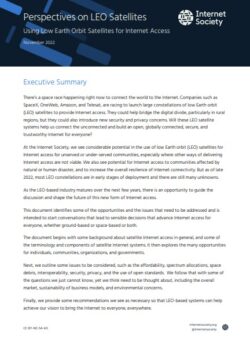Executive Summary
There’s a space race happening right now to connect the world to the Internet. Companies such as SpaceX, OneWeb, Amazon, and Telesat, are racing to launch large constellations of low Earth orbit (LEO) satellites to provide Internet access. They could help bridge the digital divide, particularly in rural regions, but they could also introduce new security and privacy concerns. Will these LEO satellite systems help us connect the unconnected and build an open, globally connected, secure, and trustworthy Internet for everyone?
At the Internet Society, we see considerable potential in the use of low Earth orbit (LEO) satellites for Internet access for unserved or under-served communities, especially where other ways of delivering Internet access are not viable. We also see potential for Internet access to communities affected by natural or human disaster, and to increase the overall resilience of Internet connectivity. But as of late 2022, most LEO constellations are in early stages of deployment and there are still many unknowns.
As the LEO-based industry matures over the next few years, there is an opportunity to guide the discussion and shape the future of this new form of Internet access.
This document identifies some of the opportunities and the issues that need to be addressed and is intended to start conversations that lead to sensible decisions that advance Internet access for everyone, whether ground-based or space-based or both.
The document begins with some background about satellite Internet access in general, and some of the terminology and components of satellite Internet systems. It then explores the many opportunities for individuals, communities, organizations, and governments.
Next, we outline some issues to be considered, such as the affordability, spectrum allocations, space debris, interoperability, security, privacy, and the use of open standards. We follow that with some of the questions we just cannot know, yet we think need to be thought about, including the overall market, sustainability of business models, and environmental concerns.
Finally, we provide some recommendations we see as necessary so that LEO-based systems can help achieve our vision to bring the Internet to everyone, everywhere.
Summary and Recommendations
We are at a pivotal time in connecting those not yet connected to the Internet and achieving universal connectivity. The combination of less expensive launch systems, smaller and mass-produced satellites, better and smaller ground antennas, and improved technology has created a situation where large-scale deployment of LEO satellite systems for Internet access is now possible. There is considerable potential to bridge the digital divide and connect many more people to the Internet using a combination of land-based and space-based Internet access solution. However, to be a useful solution to connect the unconnected, Internet access via LEO systems needs to be sustainable, as well as affordable and reliable, for the people who need it most.
LEO-based Internet access is an emerging industry using a relatively new resource (low Earth orbits) that is owned by no one, shared by everyone, but only within reach right now for a small number of entities. Without careful collaboration and thought as to how to develop this new form of Internet access to extend the Internet’s global reach as a resource to enrich people’s lives, there is a risk that a tragedy of the commons will ensue. One possible outcome: the environment will be irreversibly damaged.
A starting point has to be that no matter the method of delivery—wires, wireless, mobile, or satellite—the networks must incorporate the critical properties of the Internet and its enablers (see Appendix). This means:
- Supporting the latest open Internet standards and common, interoperable protocols that enable the open Internet
- Implementing industry best current practice for Internet security and resilience, such as those behind the Mutually Agreed Norms for Routing Security (MANRS)
- Ensuring that the information transmitted through their systems is kept private, confidential, and is not altered in transit (supporting end-to-end encryption wherever possible)
- Promoting the use of localized Internet infrastructures, such as IXPs, to connect ground stations and allow end users to have access to other networks at lower cost and latency (and exploring other options for shared infrastructure)
- Implementing the latest practices for physical and network security and ensuring systems are secure by design and practice defense in depth
- Ensuring satellites’ software can be securely upgraded remotely, and encouraging security researchers to investigate and report vulnerabilities
- Advocating for fair use of spectrum, allocated clearly and shared fairly across all technologies and operators (avoiding frequency interference)
- Being transparent about the capacity, latency, and reliability of services (and benchmarking against other forms of Internet access)
It is crucial that new entrants and new technologies be able to enter and exit the industry on a fair footing, with access to spectrum and orbits that enable them to compete effectively.
In the rush to connect the world through space, we need to limit the environmental impact of LEO based systems, including debris. Given the almost impossible task of removing space debris once it is there, LEO system providers should take whatever steps are necessary to minimize the number, volume, and type of debris their systems create before or in early stages of deployment.
Further, this is a clear case where global cooperation is needed: to address issues such as interoperability, orbital planning, interference, debris, and other environmental concerns.
If we want to bring the Internet to everyone, and if we want people to join an Internet that is open, globally connected, secure, and trustworthy, it is critical that all of us address the concerns outlined in this document. We must pursue these recommendations—and ensure that LEO satellite-based systems will deliver the Internet experience we all need to thrive.
